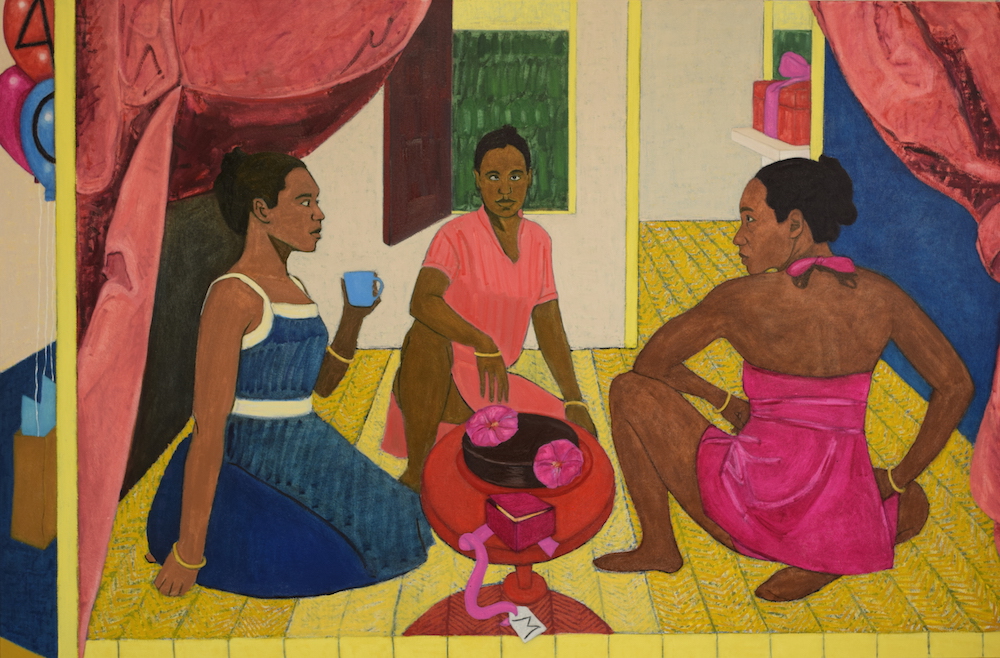
‘I think we’re slipping back into an era of tribal culture, in which you have little communities that differ in every aspect from the other little communities. That’s what identity art is, it’s tribal.’ Says Dave Hickey, the loveable art world pariah, in a recent interview published by MOMUS. Is Hickey right? It’s a matter of opinion, of course, but although I agree with the prolific references to identity in the art I come across, I believe that in fact, it is often searching for things to share and ways to connect with people that are inclusive rather than exclusive. Art that is being made by people who are themselves a multicultural, transnational, socially versatile, ethnically ambiguous hodge podge, and want to find a space to express and celebrate that. Perhaps Hickey’s feelings on ‘identity art’ are in part because he is older, male, and white, and American. When we look at things, we stand rooted in our subjective experience of the world. Perhaps my own feelings on identity art are because I am a young, mixed race, female. Neither is the correct way of seeing. There isn’t really one.
Mequitta Ahuja deals with tribalism, with identity and heritage, and with the idea of pitting identities against each other in the way Hickey imagines tribes fighting it out. In Ahuja’s work, it’s her own image that is battling it out, searching for an authentic expression of herself, a young woman, African American and Indian American, with a deep, complex and fascinating realm of influences and ideas.

Let’s start with your current appearance at Saatchi Gallery in London. What are you showing there, and how much input did you have into the pieces selected?
I have seven works on view at the Saatchi Gallery, three works on paper and four paintings on canvas. These are all works that the Saatchi Gallery purchased, so it was a joint decision. They’d purchased a few works I’d had in a solo show in New York in 2013, and then called me several month later as their exhibition was taking shape. They purchased a few more works at that time, devoting one room of the exhibition to my work.
What compels you to study of myths, folklore and ancient works?
My aim as an artist is to engage in the conversation about representation that has been going on for millennia. By employing the languages and idioms of art from the past to address my contemporary position, I update and alter the pre-existing meanings of those various art idioms and create new meanings. In addition to the Western art canon, I study stories and imagery representative of my ethnic heritage. I am African American and Indian American. By combining ideas sourced from outside of the Western canon with large format oil painting, I weave my complex cultural experience into the history of art.
You often use your own image in your paintings: When and why did you begin to do this?
Largely related to my unusual ethnic heritage and wanting, needing, to have imagery in the world that reflected my identity, I have always made self-portraits. I turned to the exclusive use of self-portraiture for the figures in my work in 2007. This was a gradual shift. As a graduate student, in order to produce source material for my work, I started photographing myself. Over time, this became an essential part of my artistic process. While I have made many changes in the imagery and themes of my work over time, one thing that has not changed is my insistence on positioning in art, a woman of colour as the central creative agent.
“Largely related to my unusual ethnic heritage and wanting, needing, to have imagery in the world that reflected my identity, I have always made self-portraits”
You use an incredible amount of material, both physical and conceptual, with lots of layers of textures and meanings. What is your studio process like?
Over time, my process has shifted from working things out on the canvas to working more and more out before I get to the canvas. Lately, my preliminary planning process has grown into a weeks-long period of drawing, looking, reading and thinking. By the time I begin work on the canvas, I have already made most of my decisions. There is, however, and I believe there will always be, a call and response aspect to painting. However much I plan beforehand, my mind works differently when I am holding a brush.
How do you know when a piece is done? Your series seem to have incredible restraint.
Since completing the works that are now on view at the Saatchi Gallery, most of which are from 2012, I have gone through another shift in my work. This shift is characterized by a process of distillation. While the works at the Saatchi Gallery reflect my additive process of building large imagery out of an accumulation of small marks, in my new work I am reducing my form to its essential components, taking anything non-essential to either the form or the meaning out of the picture. I know a piece is done when it both conforms to my original mental vision and makes maximum use of the formal discoveries I made in the process of its making.
Champagne Life closes at Saatchi Gallery on 9 March




